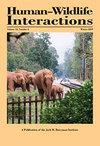Distribution and Activity Patterns of Large Carnivores and Their Implications for Human–Carnivore Conflict Management in Namibia
IF 0.9
4区 环境科学与生态学
Q4 BIODIVERSITY CONSERVATION
引用次数: 2
Abstract
Human–wildlife conflicts (HWCs) are increasing globally and contributing to the decline of wildlife species. In sub-Saharan African countries such as Namibia, most of the suitable land has been or is currently being converted to crop and livestock production to support income or subsistence agriculture. These changes in land use often incur increased levels of HWCs because of crop and livestock depredation by native species. To quantify livestock predation risks posed by carnivores in Namibia, we deployed 30 trail cameras on a 6,500-ha farm in the Khomas region of Namibia from May to July 2018. We developed occupancy models to make inferences about the factors influencing presence and temporal activity patterns of 2 carnivore species. We found that livestock were most at risk from predation by black-backed jackals (Canis mesomelas) at night in agricultural areas and from brown hyenas (Parahyaena brunnea) at night in riparian habitats. Our results suggest that farmers can reduce HWC risks by implementing animal husbandry practices to include protecting livestock at night using methods such as nighttime corrals and livestock guarding dogs (C. lupus familiaris), or herders. Increasing livestock producer access to funding (i.e., individual donations or governmental agencies) to implement improved animal husbandry practices could reduce HWCs.纳米比亚大型食肉动物的分布和活动模式及其对人类与食肉动物冲突管理的启示
人类与野生动物的冲突在全球范围内不断增加,并导致野生动物物种的减少。在撒哈拉以南非洲国家,如纳米比亚,大多数合适的土地已经或正在转为作物和牲畜生产,以支持收入或自给农业。由于本地物种对作物和牲畜的掠夺,土地利用的这些变化往往导致HWCs水平上升。为了量化食肉动物在纳米比亚造成的牲畜捕食风险,我们于2018年5月至7月在纳米比亚Khomas地区一个6500公顷的农场部署了30台跟踪摄像机。我们建立了占用模型来推断2种食肉动物存在和时间活动模式的影响因素。我们发现,在农业地区,牲畜在夜间最容易受到黑背豺(Canis mesomelas)的捕食,而在河岸栖息地,夜间最容易受到棕色鬣狗(Parahyaena brunnea)的捕食。我们的研究结果表明,农民可以通过实施畜牧业实践来降低HWC风险,包括使用夜间畜栏和家畜护卫犬(C. lupus familiaris)或牧民等方法在夜间保护牲畜。增加牲畜生产者获得资金(即个人捐赠或政府机构)的机会,以实施改进的畜牧业做法,可以减少高碳排放。
本文章由计算机程序翻译,如有差异,请以英文原文为准。
求助全文
约1分钟内获得全文
求助全文
来源期刊

Human–Wildlife Interactions
Environmental Science-Nature and Landscape Conservation
CiteScore
2.80
自引率
0.00%
发文量
0
审稿时长
11 weeks
期刊介绍:
Human–Wildlife Interactions (HWI) serves the professional needs of the wildlife biologist and manager in the arena of human–wildlife conflicts/interactions, wildlife damage management, and contemporary wildlife management. The intent of HWI is to publish original contributions on all aspects of contemporary wildlife management and human–wildlife interactions with an emphasis on scientific research and management case studies that identify and report innovative conservation strategies, technologies, tools, and partnerships that can enhance human–wildlife interactions by mitigating human–wildlife conflicts through direct and indirect management of wildlife and increased stakeholder engagement. Our intent is to promote a dialogue among wildlife professionals concerning contemporary management issues. As such, we hope to provide a repository for wildlife management science and case studies that document and share manager experiences and lessons learned.
 求助内容:
求助内容: 应助结果提醒方式:
应助结果提醒方式:


